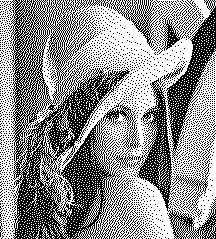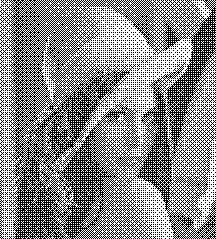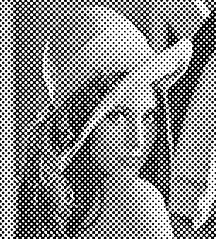 |
Halftoning basics
Halftoning is the process of rendering an image with multiple levels
of grey or colour (i.e. a continuous tone image) on a device with
fewer tones; often a bi-level device such as a printer or typesetter.
The basic premise is to trade off resolution for greater apparent
tone depth (this is known as spatial dithering).
There are many approaches to this, the simplest of which is to throw
away the low-order bits of tone information; this is what the
posterize filter does. Unfortunately, the results don't look too
good. However, no spatial resolution is lost.
By using groups of device pixels in concert more tones can be
reproduced. For example, consider the following patterns:
 Fig 1: A dispersed dot ordered
dither
As device pixels are darkened from left to right, the "grey level" of
the grid increases from 0% to 100% (albeit in coarse steps of 25%).
Note that it takes a 2 by 2 square in device space to make this
pattern, so an image halftoned using this pattern will loose a factor
of 2 resolution in both x and y-axes. By using different such
patterns, a range of effects can be achieved.
The grid the pattern is formed on is known as a screen, after the
etched glass screens used by the old photographic halftoning processes
of the 1890's.
Modern digital halftoning divides into the following areas:
Fig 1: A dispersed dot ordered
dither
As device pixels are darkened from left to right, the "grey level" of
the grid increases from 0% to 100% (albeit in coarse steps of 25%).
Note that it takes a 2 by 2 square in device space to make this
pattern, so an image halftoned using this pattern will loose a factor
of 2 resolution in both x and y-axes. By using different such
patterns, a range of effects can be achieved.
The grid the pattern is formed on is known as a screen, after the
etched glass screens used by the old photographic halftoning processes
of the 1890's.
Modern digital halftoning divides into the following areas:
- FM (frequency modulation) screening
- AM (amplitude modulation) screening, which further divides into:
FM screening is also known as stochastic screening, since it uses
random dot placement. The common Floyd-Steinberg error diffusion
algorithm is an example of such an FM screening technique. It
generates blue (i.e. high frequency) noise with few low frequency
components leading to a pleasing look.
AM dispersed dot patterns are also commonly (and incorrectly) called
"ordered dither", but actually all AM schemes are ordered, since they
share a common grid or cell structure (which is absent in FM screening
techniques).
Below are 4 pictures which exemplify the differences between these
screening techniques:
 |  |
| (a) original |
(b) FM screened |
 |  |
| (c) AM, dispersed dot |
(d) AM, clustered dot |
Fig 2: Comparision of halftoning techniques
FM screening is so-called because the spacing between dots (and thus
their spatial frequency) changes as the image tone darkens. FM
screens look much better than ordered dithers, and so are growing in
popularity. In fact, if there is little difference between the
original image above (2a) and the FM screened one (2b), this is
probably due to your browser using FM screening techiques to render
the original! FM and stochastic screening is a relatively new
technology which may replace traditional ordered dithers in the
future, but there are still plenty of people using clustered dot
ordered dithers. FM screening is not covered any further on these
pages.
Figure 2c shows the original image rendered using a 4x4 dispersed dot
ordered dither - a larger tonal range is possible at the expense of
resolution.
Finally, Figure 2d shows the image rendered using clustered ordered
dithering. The cell size is 4x4, but this time the co-ordinate grid
is skewed by 45°. The device pixels are now clustered together to
form larger spots, which grow to fill the cell as the image
tone darkens. Why not find out more
about clustered dot ordered dithers?
The topic of halftoning is a large one, and much has been written on
the subject. This list of reference material merely scratches the
surface.
- Robert Ulichney, Digital Halftoning. MIT Press, 1987
-
Rather rigourous mathematical treatment of AM screening, with a nod
towards FM screening techniques. Emphasis is on asymmetric grids.
Colour separation not addressed.
- Peter Fink, PostScript Screening: Adobe Accurate
Screens. Adobe Press. 1992
-
Packed with info on AM clustered dot screening. Includes supercell
and CMYK separation. Rather PostScript-centric (surprise-surprise!).
No other types of halftoning considered. Sadly, out of print these
days. Peter has a website
devoted to pre-press issues.
- ESCOR Panther RIP
-
ESCOR make raster image processors (RIPs), and have some very good
explanatory pages up about the general area of AM clustered dot
screening.
- Harlequin
-
Harlequin also make RIPs, and
used to have some information on halftoning on their web pages, but
they seem to have removed it.
[ On to clustered dot dithers . . . > ]
(c) 1998 Austin Donnelly <Austin_Donnelly@yahoo.co.uk>
$Id: halftone.html,v 1.6 2002/06/11 16:29:34 and1000 Exp $
|





